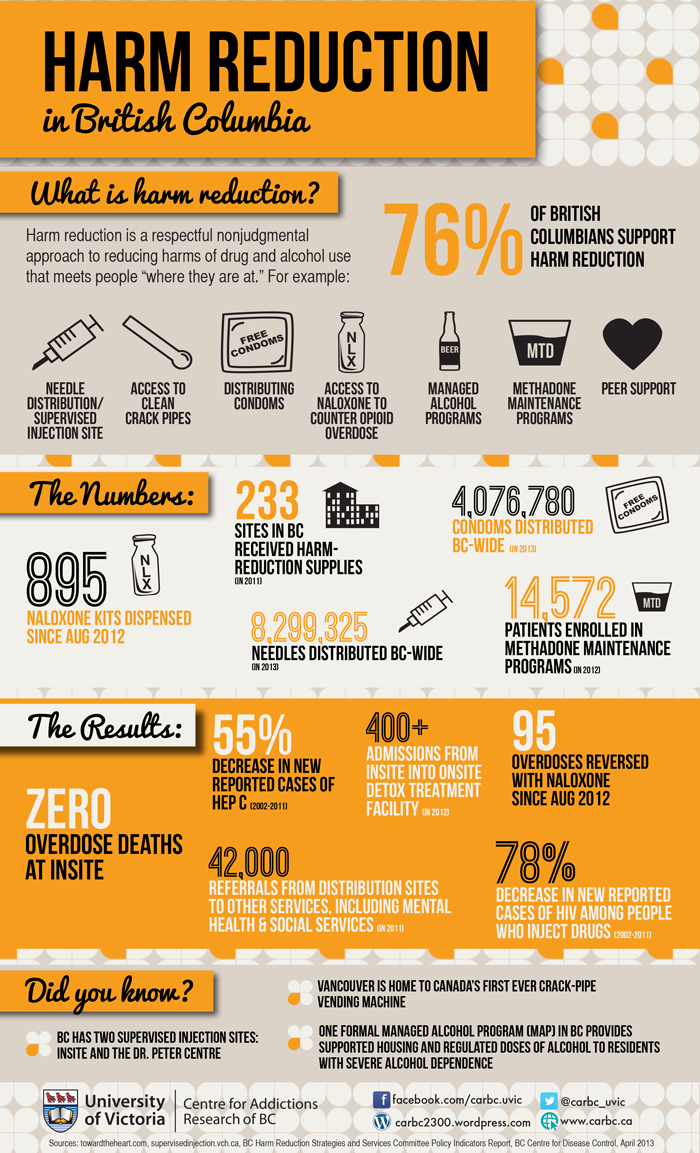This infographic by the University of Victoria’s Centre for Addictions Research of BC illustrates the first indicators of success of harm reduction programs and policies within BC.
How Do Harm Reduction Programs Work?
Firstly, harm reduction programs use drug education materials to teach people with addictions in BC communities the risks of engaging in unsafe sex, sharing needles, and using dirty crack pipes. In addition, these programs distribute condoms, sterile needles (via needle exchange programs, which also reduce the amount of disposed dirty needles) and bleaching kits (for cleaning). Overall, the numbers of naloxone kits, condoms and needles distributed to the 233 harm reduction sites in 2011 illustrate the pervasiveness of the issues and highlight the importance of such educational programs. The decrease in cases of STI's, and overdose deaths shows that education really does work.
Harm reduction programs can refer those with drug addictions to health and social services and provide access to a stable home and food. This non-intrusive approach gives people with addictions the environment in which they can manage their addiction and have the freedom to transition into assistance programs as they see fit. As can be seen in the below infographic, over 42,000 referrals to other services have been made and over 400 drug-users have entered detox programs. This less-intrusive approach has shown to work well in treating drug addiction.
Harm reduction programs also use two innovative programs, Methadone maintenance treatments (MMT), the practice of giving controlled portions of methadone to heroin users, and Supervised Consumption Facilities (SCFs) which are legally and medically sanctioned facilities, allowing for the controlled consumption of drugs by drug users to control cases of overdose and health issues. Insite, North America’s first legal supervised injection site in Vancouver, is one of such innovative programs has proven to be a success and has had zero patients who have overdosed. What these programs offer is a pragmatic alternative to those managing long-term addictions, in a safe and supportive environment. MMT and SCFs can also help to prevent the stigmatization of addiction, allowing for people with addictions to be slowly integrated into society through a series of social and medical programs.
The infographic also illustrates that harm reduction programs in BC have begun developing programs to address severe alcohol dependence and provide supported housing. Although the study of this program shows promising trends, a more rigorous, and well-contolled evaluation is needed.
Do British Columbians Support Harm Reduction?
Although few areas in British Columbia face challenges with implementing harm reduction programs (as indicated by the 76% of British Columbians who approve of harm reduction programs on the infographic), there are a number of cases of localized opposition.
Smaller communities in Victoria have closed harm reduction needle sites, due to the perceived public opinion of policy makers “condoning” drug-abuse. These communities fear making the wrong choice. Such attitudes displayed by a minority of communities in BC illustrate just one of the barriers harm reduction programs encounter when looking to expand to smaller communities.
But in fact, reasearch has shown time and time again that these concerns are unsubstantiated. Harm reduction programs are proven to work for both the public and individual good.


